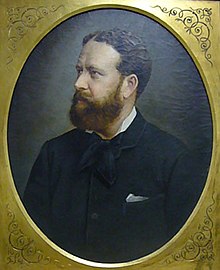Theodor Eimer


Gustav Heinrich Theodor Eimer (22 February 1843 – 29 May 1898) was a German zoologist.
Life[]
Eimer was born in Stäfa, Switzerland. He studied medicine and natural sciences in Tübingen, Freiburg, Heidelberg and Berlin, where he earned his doctorate in medicine in 1867, followed a year later by a Ph.D. in Würzburg. After spending his junior faculty years as prosector at University of Würzburg, he became in 1875 a professor of zoology and comparative anatomy at the University of Tübingen. Eimer was one of the founders of the German Zoological Society.[1]
On 18 July 1870 he married the artist . Anna would illustrate his scientific publications throughout their marriage.[2]
Eimer is credited with popularizing the term orthogenesis (originally introduced by Wilhelm Haacke in 1893) to describe evolution directed in specific pathways due to restrictions in the direction of variation. Though his theories gained popularity in Germany in the 1880s, his work was not widely known in the English-speaking world until 1890 when his work Die Entstehung der Arten auf Grund von Vererben erworbener Eigenschaften nach den Gesetzen organischen Waschsens(1888) was translated by Joseph Thomas Cunningham as Organic Evolution as the Result of the inheritance of Acquired Characters according to the Laws of Organic Growth. This book was predominantly a Neo-Lamarckian polemic against August Weismann, his compatriot Neo-Darwinian. Eimer's later work, translated as On Orthogenesis, was a more rigidly orthogenetic text, whereas Organic Evolution maintained a plurality of mechanisms for species formation.
The "Eimer's organs" found in members of the mole family, especially in the star-nosed mole, are named after him. He described these organs in the European mole in 1871. Eimeria, a genus of parasitic protozoa, was also named after him.
Maria Linden became a precocious female student of Eimer's. Under Eimer's guidance she was awarded a degree and in 1895 she completed her thesis on the evolution of a snail's shell and she was awarded a doctorate in Natural Science. She worked as an assistant to Eimer until 1899.[3]
He also studied the systematics of Papilionidae. Eimer, G. H. T. Die Artbildung und Verwandschaft bei den Schmetterlingen. Eine systematische Darstellung der Abänderungen, Abarten und Arten der Segelfalter-ähnlichen Formen der Gattung Papilio. xii + 243 pp., 4 pls., 23 figs., Gustav Fischer, Jena, 1889 was published posthoumously from 1889.
Eimer died in Tübingen.
References[]
- ^ Andreas W. Daum, Wissenschaftspopularisierung im 19. Jahrhundert: Bürgerliche Kultur, naturwissenschaftliche Bildung und die deutsche Öffentlichkeit, 1848–1914. Munich: Oldenbourg, 1998, pp. 245, 365, 389, 431, 485, including a brief biography.
- ^ Churchill, Frederick B. (2015). August Weismann. Harvard University Press. ISBN 9780674286856.
- ^ Mary R. S. Creese; Thomas M. Creese (2004). Ladies in the Laboratory 2. Scarecrow Press. pp. 119–122. ISBN 978-0-8108-4979-2.
- Gaedecke, R. and Groll, E. K. (Hrsg.): Biografien der Entomologen der Welt: Datenbank. Version 4.15: Senckenberg Deutsches Entomologisches Institut, 2010 [1]
External links[]
![]() Media related to Theodor Eimer at Wikimedia Commons
Media related to Theodor Eimer at Wikimedia Commons
- 1843 births
- 1898 deaths
- German entomologists
- German zoologists
- Orthogenesis
- People from Stäfa